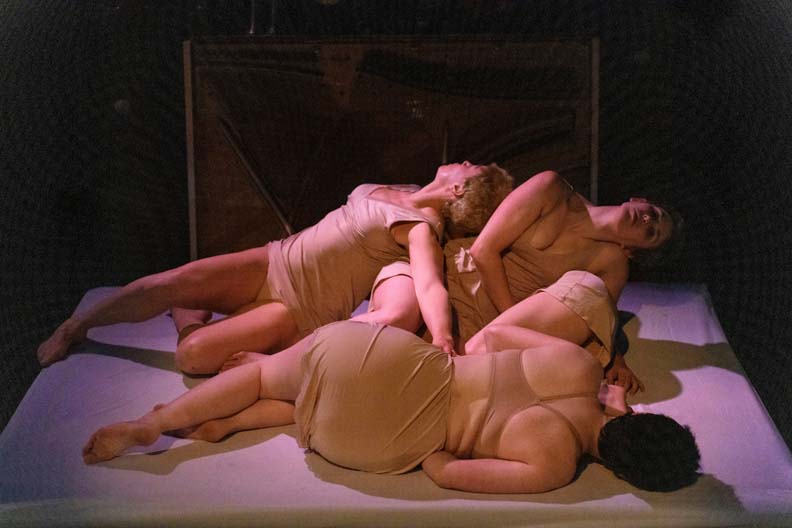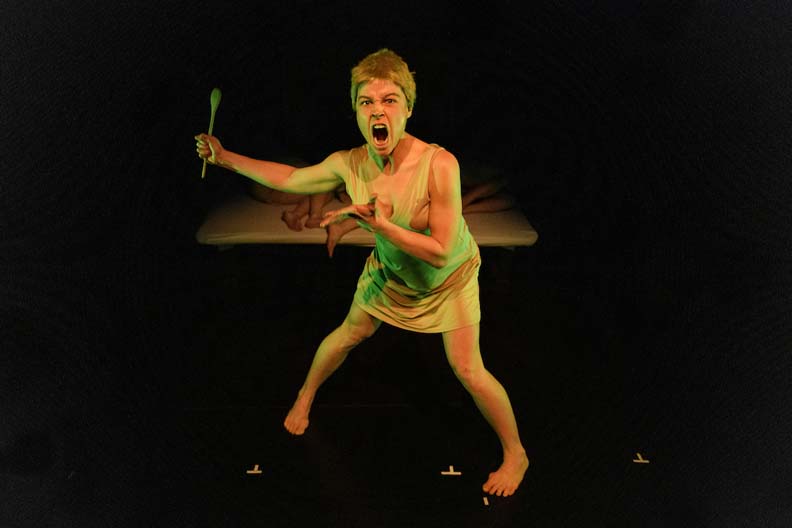Horrifying history in the cardiac shadow

Walking out of the cardiac shadow, the only way I could immediately think of describing the show was ‘horrible’. I tried to get myself to expand on that thought: ‘poetic and beautiful, but still horrible’.
Let me clarify, not horrible in terms of being terrible, horrible in the traditional meaning: to cause horror. To be so full of dread because we can reasonably guess what will happen to these four women, selected from the Ravensbrück concentration camp to participate in Nazi medical experiments, even as we are whisked away by their hopes, pain, love, and darkest moments. And as weird as it may sound, that’s a good thing with the cardiac shadow – it means the play and this production hit its mark.
the cardiac shadow, written by Clay McLeod Chapman and co-produced by Northern Light Theatre and Good Women Dance Collective is not an easy show to experience, but it’s one that I think is particularly important in today’s political climate and contemporary society. And I use the word ‘experience’ specifically. The show is certainly a play, but it’s also something more, having combined video, a sound design that underpins the entire show, dance, and voice acting into this full-featured production that runs at the Studio Theatre in the ATB Financial Arts Barns until February 2.

In the cardiac shadow, Dr. Rascher (the Nazi doctor who orchestrated the freezing experiments, as voiced by Vance Avery) explains the origins of his experiments and obsession with the human body through the lens of his young daughter and how she innocently moves through the world, unknowing of the mysteries and complexities of her own body. In these opening moments, we see Katrina’ Betty’s video design of a young girl playing dress up in the snow with various Jewish artifacts, which eventually dissolve into footage from concentration camps. At this point, the Good Women Dance Collective (Alida Kendell, Alison Kause, Kate Stashko, and Ainsley Hillyard) enter the stage, passing through the barbed wire of Trevor Schmidt’s set design that separates us from them – the performers from the observers. Each woman is then given a monologue (voice acted by Nadien Chu, Elisa Benzer, Rachel Bowron, and Megan Dart) accompanied by a movement piece that gives a window into the emotional labour, determination, and coping mechanisms one might use to attempt to survive such a horrifying situation. Throughout the play, there are moments of love, pain, grit, and glimmers of hope that are a cause for reflection on the strength of the human spirit.
Though the subject matter is dark and heavy, the shows production elements bring a poetic beauty to the telling of the story. The movement work has a dream-like quality to it, which matches the pace of the voice acting and really does make one feel as though we are watching the inner goings on of the women’s minds. Dave Clarke’s sound design is a constant score to the 60-minute piece and adds an emotional layer to the show that is not conveyed by the mostly stoic expressions on the dancers’ faces as they are meant to be imagining themselves removed from their physical bodies. Katrina Beatty’s video and projections set the place and walk the fine line of humanizing not the doctor, but the victims of the Holocaust, by bringing to life the rings, menorah, clothes, hair and other belongings stripped of those who entered the concentration camps. Trevor Schmidt’s set design firmly places the audience in the role of the observer – the outsider looking in on the experiment. This set up doesn’t just show us the events of the Holocaust, it places us into the shoes of the ordinary people who stood by until it was too late.
Which brings me back to the idea of why? Why now? Why this play? It shows humanity at our most horrible without any need for gruesome images or descriptions because it takes advantage of the most intricate theatre of all – the theatre of the mind. So, why see it? And the simple answer is that the resonance this play has today, where racial tensions and an idea of ‘us versus them’ seems to be constantly on the rise and where we’re giving more and more of ourselves over to the government and (even more terrifying) corporations, it’s important to remember lessons history should have taught us. Specifically, the lessons that will help us recognize what the consequences can be when steps which seem little or innocuous or even necessary at the time quickly go out of hand. It ensures that
every time we step out into that bracing -30 January weather, we remember the story of the four nameless women and countless anonymous men who were the victims of these experiments during the Holocaust.
the cardiac shadow plays at the Studio Theatre in the ATB Financial Arts Barns January 18 – February 2. Tickets are $26.25 – $31.50 through Northern Light’s box office. Special events during the run are as follows:
- Sunday, January 20 (matinee) – Pre-show director’s circle event
- Tuesday, January 22 – two-for-one tickets at the door
- Wednesday, January 23 – post-show NLT guest speaker salon
- Thursday, January 24 – post-show actor talk back
- Tuesday, January 29 – two-for-one tickets at the door
